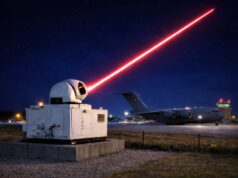Typhoon fighter jets from 3 Squadron have returned to Estonia as part of the ongoing Royal Air Force support to the British Army led NATO battlegroup deployed there.
The Typhoons have been based at Amari Air base Estonia and have been conducting challenging air land Integration training exercises with the deployed ground controllers known as JTACs or Joint Terminal Air Controllers.
The first sorties flown were conducted at night over a training area in eastern Estonia before returning the next day to conduct daylight simulated air strikes and also “show of force” low passes.
According to a press release:
“The pilots for the daylight sorties faced the additional challenges of conducting their training in between heavy flurries of snow a new experience for them. The simulated air strikes however were accessed as having been successful and achieved the objectives the ground commander set out to achieve.
The British led NATO battlegroup the Typhoons trained with, is formed around the 1st Battalion the Royal Welsh and is the Estonian based element of the NATO Enhanced Forward Presence that was first announced at the NATO summit at Wesaw in 2016.”
One of the pilots, Ed, a Flight Lieutenant, was quoted as saying:
“The training sorties provided an excellent opportunity to work with the deployed JTACS in very challenging and unfamiliar surroundings.”













Morning
Sounds like an awful lot going on in Estonia at the moment.
An under armed, unbalanced and poorly logistically supported battle group (10 CR2 – really??) and a couple of Typhoons who, by the sounds of it don’t operate that well in the snow.
What does “assessed to have been successful” mean? Sounds like fail to me.
You are either successful or you are not, no assessing required really when it comes to the deployment of kenetic weapons.
The commitment to the Baltic states is ongoing which is why the Welsh took over from the 800 Rifles (who have been there since March)
https://twitter.com/BritishArmy/status/939557803374596097
and no doubt somebody has been pencilled in to replace the welsh also.
It is a deterrent, nothing more.
If Putin wants more territorial expansion he must mess with NATO.
And If some idiot in the west or NATO starts thinking massing NATO armies on the Russian border is a good idea then we are inflaming the situation.
Totally agree with you Daniele.. It’s to give some reassurance to out Baltic NATO allies and basically to act as a trip wire you could say. No need to build NATO forces up to levels that would look more aggressive along the Baltic/Russian Border, can you imagine instead of NATO sending three battle groups to support the Baltic nations they had sent three brigades (Division) no need to do that currently.
our*